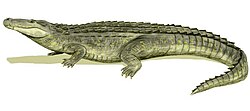| Alligator thomsoni Temporal range: Miocene | |
|---|---|
| Scientific classification | |
| Kingdom: | Animalia |
| Phylum: | Chordata |
| Class: | Reptilia |
| Clade: | Archosauria |
| Order: | Crocodilia |
| Family: | Alligatoridae |
| Genus: | Alligator |
| Species: | †A. thomsoni |
| Binomial name | |
| †Alligator thomsoni Mook, 1923 | |
Alligator thomsoni is an extinct species of alligator that existed during the Early Miocene period. Their range was principally in what is now known as Nebraska, United States. [1] [2]


